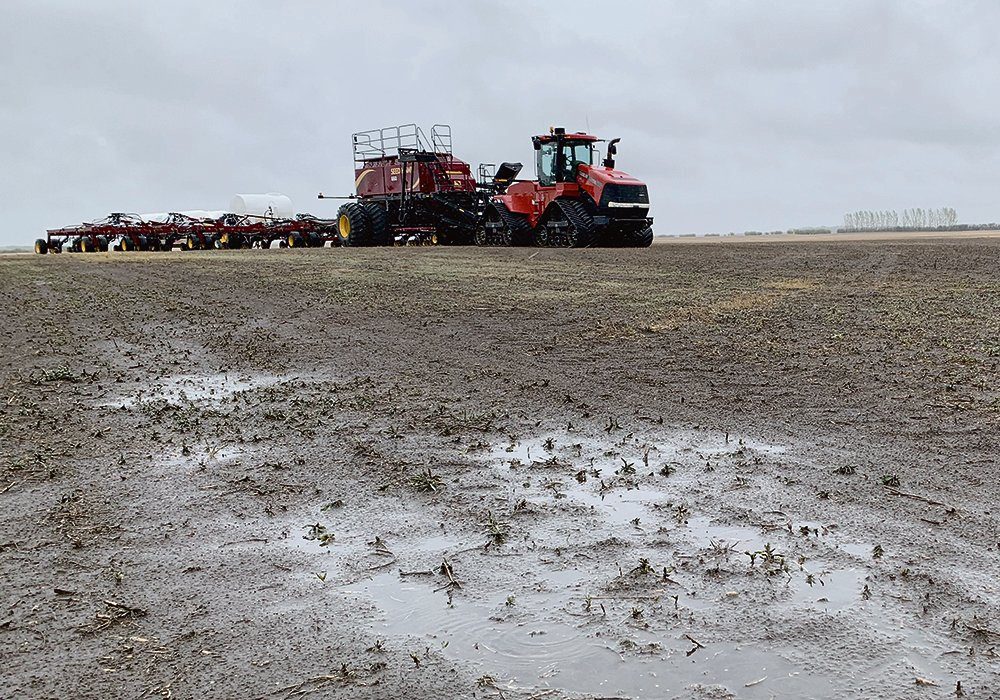Rain to the rescue | The Western Producer

Recent precipitation across the Prairies has been described as a billion-dollar rainfall, coming just in time to alleviate widespread drought concerns for now.
Rainfall of generally 25 millimetres or more fell throughout the parched grainbelt in all three provinces through the May long weekend and some areas also received wet snow.
The event prompted retired Alberta soil and crop researcher Ross McKenzie to tweet that an inch of precipitation, or 25 mm, is worth more than $2.6 billion on the approximately 66 million acres of crop land.
He said crop value can rise from $30 to $60 per acre with increasing yield from an inch of rain.
He said the figure is general because obviously individual fields, soils and crops all respond differently to moisture and crop prices vary. However, he said a rule of thumb is that 25 mm of rain will increase wheat yields between five and nine bushels, depending on growing conditions.
“If a bushel of wheat is worth $8, and you get five more bushels, that’s worth $40 per acre,” he said in an interview.
He used that $40 in his overall calculation.
McKenzie said barley could gain six to 10 bu. per acre, while canola can increase 3.5 bu. per acre and even as high as five or six with some of the new hybrids.
A six-bu. increase per acre at today’s canola prices is significant, he said.
And, for higher value crops such as sugar beets and corn under irrigation, the benefits of 25 mm of rain can be $60 to $70 per acre.
He cautioned that it’s early in the growing season but the rain has added some value to crops.
“Things were very dry and if we had run another two weeks without it we would have been in serious trouble,” he said.
In Alberta, only the northern half of the Peace region didn’t get some form of moisture. Heavy snow fell May 17-19 and rain followed. Most of the south and part of the northeast regions saw 20 to 50 mm, while central and parts of the northwest received 10 to 15 mm, according to the province’s crop report.
Matt Struthers, crops extension specialist at Saskatchewan’s agriculture knowledge centre, said the moisture would help germination and later-seeded crops. Amounts ranged from zero in a few places to the highest reported of 116 mm at Limerick. Most regions saw 25 mm and more.
“In the middle of June we are going to need another rain of an inch or two,” Struthers said.
Rob Stone, who farms at Davidson, Sask., said farmers are relieved, particularly after seeding canola into dust.
“The most immediate pressing concern (when it’s dry) is not having enough rain to bring your crop to full potential,” he said. “It’s kind of annoying and frustrating that you do all this work and you maybe only have average yield.”
On his farm, snow and rain resulted in about 50 mm of water.
“That snow moisture was enough to saturate the seed row and you could tell that everything was taking on moisture,” he said, referring to about one centimetre of snow. “Then the icing on the cake was having another inch and a bit come very slow over a couple days. The problems aren’t fixed… but we get to check a box anyway that we’ll have emergence.”
Manitoba also saw spotty to widespread rain to help germination.
Rainfall ranged from less than 10 mm in some places to some localized regions in the east that saw 100 mm. However, generally the amounts ranged from 15 to 35 mm.
In all three provinces, cattle producers say they need more rain to fill dugouts, but it would help some hay crops and pastures.
In Manitoba’s Interlake region, there were reports that alfalfa was ready to bloom at 15 cm in height or shorter and there is already concern about next year’s feed supply.
In Saskatchewan, Struthers said water quality is a concern but he hoped the rain had helped with concerns about sulfate concentration.
Source: producer.com

